|
  






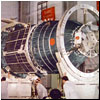


L1 No. 13L




|
7K-L1: Soyuz for circumlunar mission
In 1964, the USSR started a new program aimed to fly two cosmonauts around the Moon. It had a purely political goal of denying the US the most ambitious achievement in space short of the actual landing on the lunar surface. In order to meet mass restrictions for a flight toward the Moon on the UR-500 (Proton) rocket, the Soyuz had lose all its unessential systems, resulting in the 7K-L1 variant.
Previous chapter: Chelomei's LK project

The unpiloted version of the L1 spacecraft, officially known as Zond. Credit: RKK Energia

Key components of the 7K-L1 spacecraft and its payload section designated 11S824: 1) 7K-L1 spacecraft; 2) Block D space tug; 3) Payload fairing; 4) Launch vehicle adapter; 5) Emergency escape system; 6) The 8K82K (Proton) launch vehicle; 7) Support cone.
Known specifications of the 7K-L1 spacecraft:
| Crew |
2 |
| Flight duration |
7 days |
| Spacecraft mass (after separation from the Block D upper stage), including... |
5,500, 5,630 (774), 5,680 (52) kilograms |
- Spacecraft mass in low Earth orbit
|
19,040 kilograms |
|
3,100 kilograms |
- Instrument compartment mass
|
2,250 kilograms |
- Fairing attachment cone mass
|
150 kilograms |
| Block D liftoff mass |
|
| L1 spacecraft propellant supply |
|
| Spacecraft length |
*4.796 meters |
| Spacecraft diameter |
|
| Solar panels span |
~9 meters |
| Solar panels area |
11 square meters |
| Block D length |
5.5 meters |
| Block D diameter |
3.7 meters |
| Spacecraft internal volume |
5.5 cubic meters |
| Internal free volume |
2.6 cubic meters |
| 7K propellant components |
AK-27 (oxidizer), UDMH (fuel) |
| Block D propellant components |
Liquid oxygen (oxidizer), Kerosene RG-1 (fuel) |
| L1 spacecraft propulsion system thrust |
4,033 kilonewtons (2); 425 kilograms (52) |
| Block D propulsion system thrust |
|
| L1 spacecraft propulsion system specific impulse |
276 seconds per kilogram (52) |
| Block D propulsion system specific impulse |
346 seconds per kilogram (52) |
The L1 was essentially a two-seat Soyuz spacecraft stripped of its habitation module to bring its mass down to as low as five tons. The spacecraft also lacked a backup parachute container, which was apparently replaced with an entrance hatch!
Because the development of the 7K-L1 variant trailed the work on the original Soyuz 7K-OK spacecraft, Korolev's engineers had a chance to integrate a number of new systems into the L1, which were not present on the Earth-orbiting Soyuz. For example, the L1 would be equipped with the first Soviet flight control computer -- Argon-11s.
The Block D (11S824) upper stage had minimal changes compared to its original design developed for the N1 rocket. A spherical oxygen tank had a cylindrical insert, which increased its volume. It also had a two-section payload fairing. (84)
The official "basic specifications" of the L1 upper composite (11S824) were approved on Dec. 31, 1965. This document listed following key development activities and upgrades within the 7K-L1 project:
- The use of the Block D stage from the N1/L3 complex;
- The use of the 7K spacecraft sans a habitation module, BO, with an upgrade of its descent module, SA, to reenter with a second cosmic speed. In order to install attachments of the emergency escape system, which normally interface with now missing habitation module, it would be replaced with a small external module. Named "base cone," the compartment would contain extra power batteries;
- The removal the orientation and berthing thrusters, DPO, from the 7K spacecraft. Their functions would be transferred to the SOZ (engine ignition) propulsion system on the Block D stage;
- The development of the new cone-shaped payload fairing is developed specifically for the 7K-L1 spacecraft;
- The introduction of an additional engine firing of the Block D stage to enter an initial parking orbit. A subsequent firing of Block D would be used to develop a second cosmic speed;
- The development of a flight sequence of the Proton/payload composite system to ensure the normal functioning of the emergency escape system and the launch vehicle safety system (monitoring the health of the vehicle during the ascent with the crew);
- The development of the flight trajectory taking the spacecraft around the Moon and returning the descent module back to Earth with the second cosmic speed;
- The testing of the L1 complex in the Earth orbit during the launches of vehicles No. 2P and No. 3P (where "P" probably stood for "prosteishiy" -- simplest (or "probny" - testing or "prototip" - prototype.) Both ships were to have simplified flight control system but equipped with Block D stages.
The same basic specifications also planned activities on the 7K-L1 spacecraft:
- The development of the 7K spacecraft variant for a one-launch circumlunar flight scenario.
- Phased fulfillment of flight testing including following vehicles:
- Technical mockup complex 1M1 with the vehicle No. 1P;
- A fully operational version of the L1 spacecraft and its payload section but without a crew for taking photos of the Earth and the Moon during launches of vehicles No. 4, 5, 6, 7, 8 and later No. 8 and 9)
- Preparation of vehicles No. 11, 12, 13 and 14 for manned flight during a one-launch scenario, but with a possibility of launching them unmanned (if flight testing reveals problems in earlier flights).
At the time, the spacecraft was expected to have following specifications:
| 7K-L1 spacecraft mass at liftoff |
depending on variant 5,200-5,700 kilograms
|
| 7K-L1 spacecraft mass at Earth escape maneuver |
|
| Maximum length of the spacecraft body (without antennas) |
|
| Descent module diameter |
|
| A total volume |
|
At the time, a provisional flight of the L1 spacecraft was expected to last from eight to 10 days, or up to two times longer than the maximum flight duration achieved by the USSR during the Vostok-5 mission in 1963.
For the L1 missions, the descent modules would be equipped with new, more extensive heat shield than the one developed for the Soyuz
L1 propulsion system
The L1 spacecraft would be equipped with a KTDU-53 propulsion system (also known as the S5.53 engine) developed at Isaev's design bureau.
Flight profile for the L1 project

1) Initial orbit insertion; 2) Initial parking orbit; 3) Trans-lunar insertion maneuver; 4) Trans-lunar trajectory correction; 5) Lunar flyby; 6) Second trajectory correction; 7) Third trajectory correction; 8) Separation between the descent module and the aggregate compartment; 9) Reentry and landing
During a typical L1 mission, the three-stage 8K82K rocket (a.k.a. UR-500K Proton) lifts off from Tyuratam. The payload fairing would be jettisoned with the help of small solid propellant motors during the firing of the second stage.
After the separation of the third stage, Block D (11S824) would make its first of two firings with its 11D58 engine lasting 140 seconds to enter a 205-kilometer parking orbit, with an inclination 51.5 degrees toward the Equator. (52)
After a passive flight, Block D fires again to insert the 7K-L1 spacecraft into a trans-lunar trajectory. The 7K-L1 would then separate from Block D as it speeded toward the Moon. After the ship's actual trajectory was carefully measured against the planned parameters, the spacecraft would have an opportunity to make a correction with its own engine at a distance of around 250,000 kilometers from Earth. It would then swing behind the Moon at a minimal distance of around 2,000 kilometers conducting photography and remote-sensing experiments.
The spacecraft would head back to Earth and make another trajectory correction maneuver at a distance of around 150,000 kilometers from the home planet. The descent module with the crew would then separate and make an aerodynamic reentry into the Earth's atmosphere to land on the Soviet territory between seven or eight days after launch.
Missions of the 7K-L1 spacecraft:
1 |
|
7K-L1
No. 2P |
March
10, 1967 |
- |
Tested
systems of the Block D upper stage |
2 |
|
7K-L1
No. 3P |
April
8, 1967 |
- |
A
second firing of the Block D failed in Earth's orbit |
3 |
|
7K-L1
No. 4L |
Sept.
28, 1967 |
- |
Proton's
1st stage failed; escape system saved the reentry craft |
4 |
|
7K-L1
No. 5L |
Nov.
22, 1967 |
- |
UR-500K's
2nd stage failed. The escape system saved a reentry craft |
5 |
|
7K-L1
No. 6L |
March
2, 1968 |
- |
The
descent module self-destructed during reentry |
6 |
|
7K-L1
No. 7L |
April
23, 1968 |
- |
Escape
system self-initiated during launch |
7 |
|
7K-L1
No. 8L |
- |
- |
An on-pad
explosion of the upper stage killed one person; craft damaged |
8 |
|
7K-L1
No. 9L |
Sept.
15, 1968 |
Sept.
21, 1968 |
Flew
around the Moon; splashed down in the Indian Ocean |
9 |
|
7K-L1
No. 12L* |
Nov.
10, 1968 |
Nov.
17, 1968 |
Flew
around the Moon; reentry craft depressurized during landing and
crashed |
10 |
|
7K-L1
No. 13L |
Jan.
20, 1969 |
- |
UR-500K's 2nd stage and 3rd stages fail; the escape system save reentry craft |
11 |
|
7K-L1
No. 11L |
Aug.
8, 1969 |
Aug.
14, 1969 |
Flew
around the Moon |
12 |
|
7K-L1
No. 14L |
Oct.
20, 1970 |
Oct.
27, 1970 |
Flew
around the Moon; landed in the Indian Ocean |
|



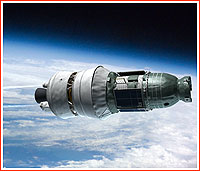

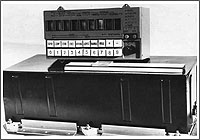


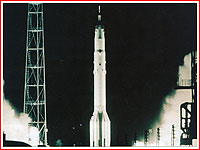
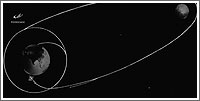
|
